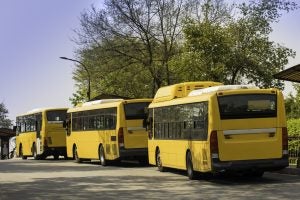 Every pre-COVID school day, approximately 480,000 school buses carry more than 25 million children to school across the United States. Most of them run on diesel fuel and spew pollution that causes cancer, triggers asthma attacks and makes climate change worse. Indeed, of the over 40,000 school buses registered in the U.S. in 2019, only 240 were zero-emission (and only about 1% of school buses are electric). This picture will not improve without intervention — barring additional measures, only 27,000 of the projected 560,000 school buses that will be built in the next 10 years will be electric.
Every pre-COVID school day, approximately 480,000 school buses carry more than 25 million children to school across the United States. Most of them run on diesel fuel and spew pollution that causes cancer, triggers asthma attacks and makes climate change worse. Indeed, of the over 40,000 school buses registered in the U.S. in 2019, only 240 were zero-emission (and only about 1% of school buses are electric). This picture will not improve without intervention — barring additional measures, only 27,000 of the projected 560,000 school buses that will be built in the next 10 years will be electric.
Luckily, that intervention is starting to arrive. Today, Senator Cortez-Masto (D-NV), Senator Murray (D-WA), Representative Cardenas (D-CA) and Representative Hayes (D-CT) introduced the Clean School Bus Act a groundbreaking piece of legislation that will provide grants for infrastructure and vehicles, with an emphasis on deploying them in communities hardest hit by health-impacting air pollution.
Zero emissions from tailpipes mean healthier children
Diesel school buses put one of America’s most vulnerable populations at risk. Aside from polluting the community, estimates indicate that the interior cabin of a diesel bus is five times higher than what a driver directly in front of the bus experiences. Because children’s lungs haven’t fully developed and they breathe at a more rapid rate than adults, the impact of this harmful pollution is exacerbated in school-age children. The result? Respiratory illness, worsening asthma and poor performance in class. Zero-emission buses will help mitigate these health issues — and lower income communities and children living in communities disproportionately impacted by emissions from multiple sources should be prioritized.
A teachable moment: Zero-emission school buses are a winning proposition Share on XBuses can save operators money
Zero-emission school buses have a higher upfront cost than their diesel counterparts, making financial interventions like the Clean School Bus Act critical. However, school buses provide a multitude of other cost savings. Electric school buses are almost 60% more energy efficient than their diesel counterparts and require far less maintenance, given that they have fewer rotating and moving parts. They are 60% less costly to operate and maintain and can save school districts almost $2,000 a year per bus in fuel costs and $4,400 a year per bus in maintenance costs. And, if utilities design incentives to charge at low-cost times, these fuel cost savings could be even greater.
Zero-emission school buses can provide important grid services
Electric buses are large rolling batteries that can provide important grid services. Given their predictable routes, they can manage charging more easily than other segments. Because they often sit idle for much of the day, they can concentrate charging at off-peak times and at times in which the energy mix is dominated by renewables. Additionally, manufacturers like Lion are increasingly making vehicle-to-grid capabilities standard on their buses. This capability can provide energy to the grid at times when the system is strained. During localized power outages, V2G school buses can provide energy to buildings like schools and community centers. If these services are valued on par with similar capabilities, payment for V2G services can further the economic benefit of these vehicles for school districts.
Zero-emission school buses are market-ready
The supply of zero-emission trucks and buses is rapidly increasing in tandem with falling prices. Blue Bird, Thomas Built, IC Bus, GreenPower, and Lion have all released or announced fully electric buses. The number of manufacturers in this space and constantly evolving technology will only strengthen the market for this sector in the coming years.
Clean school buses are ready to roll. The industry has the technology to revolutionize how children get to school, and the benefits can provide wins for school districts’ budgets, the grid and, most critically, the health of our children. A strong nudge, like the one presented by Senator Cortez-Masto, can help realize those deep benefits much more quickly.









